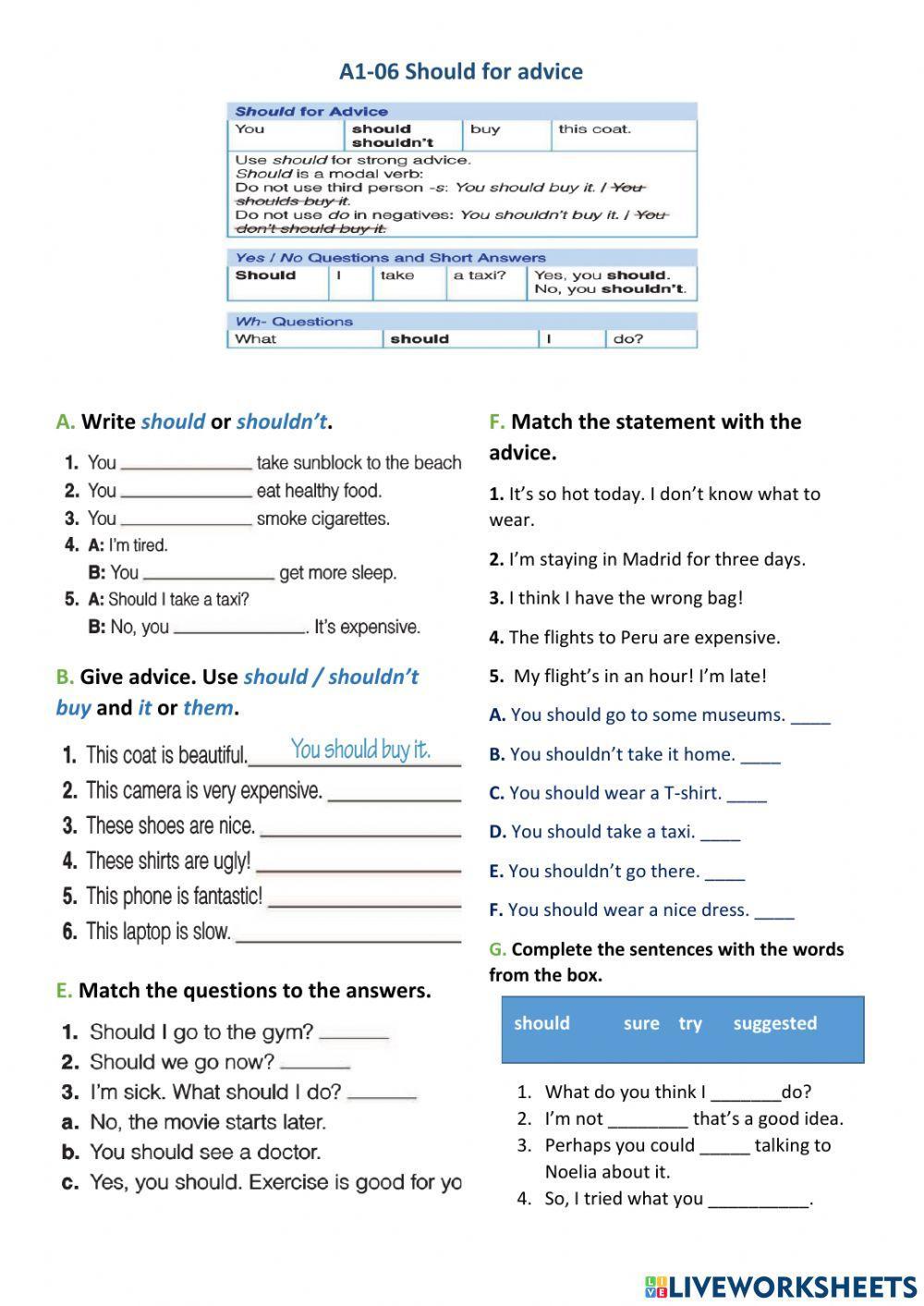Loading ad...
Member for
4 yearsAge: 14+
Level: 4th
Language: English
(en)
ID: 1554936
22/10/2021
Country code: PE
Country: Peru
Main content: Should or shouldn't (2012830)
From worksheet author:
should or shouldn't for advice
Other contents:
advice with should or shouldn't
Worksheet description:
Objective Explanation:
This worksheet aims to help students understand and practice the correct usage of "should" and "shouldn't" for giving advice. By the end of the worksheet, students should be able to differentiate between strong advice using "should" and prohibitions using "shouldn't" in various contexts.
Content Overview:
The main content of this worksheet revolves around the use of "should" for advice. It covers examples of strong advice, modal verb usage, and how to form yes/no questions and short answers using "should." Students will also practice writing sentences using "should" or "shouldn't" based on different scenarios presented in the exercises.
Language and Educational Level Context:
This worksheet is designed for students studying English as a Second Language (ESL) at a beginner level. The exercises are structured to help students grasp the basic concept of giving advice using "should" in a simple and straightforward manner. The language used is appropriate for students who are new to learning English grammar rules.
Subject Relevance:
The content of this worksheet directly ties into the subject of English as a Second Language (ESL) by focusing on a fundamental aspect of grammar - giving advice using modal verbs. Understanding how to use "should" and "shouldn't" correctly is essential for ESL students as it allows them to communicate effectively and make suggestions in various situations.
Instructions:
The instructions provided in the worksheet guide students on how to use "should" for giving advice. They explain the rules of using "should" as a modal verb, emphasizing the correct structure for affirmative and negative sentences. Examples of yes/no questions and short answers using "should" are also included to demonstrate practical application. Additionally, students are tasked with writing sentences using "should" or "shouldn't" in response to different scenarios presented in the exercises. By following these instructions, students can effectively learn and practice the use of "should" for advice in English.
This worksheet aims to help students understand and practice the correct usage of "should" and "shouldn't" for giving advice. By the end of the worksheet, students should be able to differentiate between strong advice using "should" and prohibitions using "shouldn't" in various contexts.
Content Overview:
The main content of this worksheet revolves around the use of "should" for advice. It covers examples of strong advice, modal verb usage, and how to form yes/no questions and short answers using "should." Students will also practice writing sentences using "should" or "shouldn't" based on different scenarios presented in the exercises.
Language and Educational Level Context:
This worksheet is designed for students studying English as a Second Language (ESL) at a beginner level. The exercises are structured to help students grasp the basic concept of giving advice using "should" in a simple and straightforward manner. The language used is appropriate for students who are new to learning English grammar rules.
Subject Relevance:
The content of this worksheet directly ties into the subject of English as a Second Language (ESL) by focusing on a fundamental aspect of grammar - giving advice using modal verbs. Understanding how to use "should" and "shouldn't" correctly is essential for ESL students as it allows them to communicate effectively and make suggestions in various situations.
Instructions:
The instructions provided in the worksheet guide students on how to use "should" for giving advice. They explain the rules of using "should" as a modal verb, emphasizing the correct structure for affirmative and negative sentences. Examples of yes/no questions and short answers using "should" are also included to demonstrate practical application. Additionally, students are tasked with writing sentences using "should" or "shouldn't" in response to different scenarios presented in the exercises. By following these instructions, students can effectively learn and practice the use of "should" for advice in English.
Share / Print Worksheet
